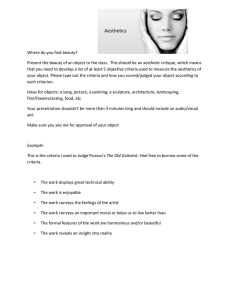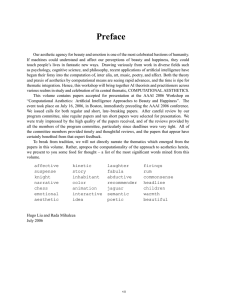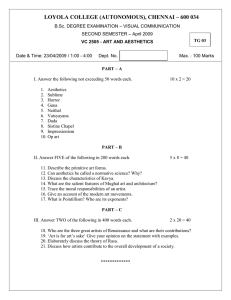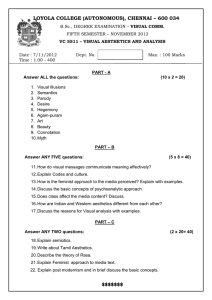Concepts of “Aesthetics of Arts” in Slovak Aesthetics of the 19
advertisement
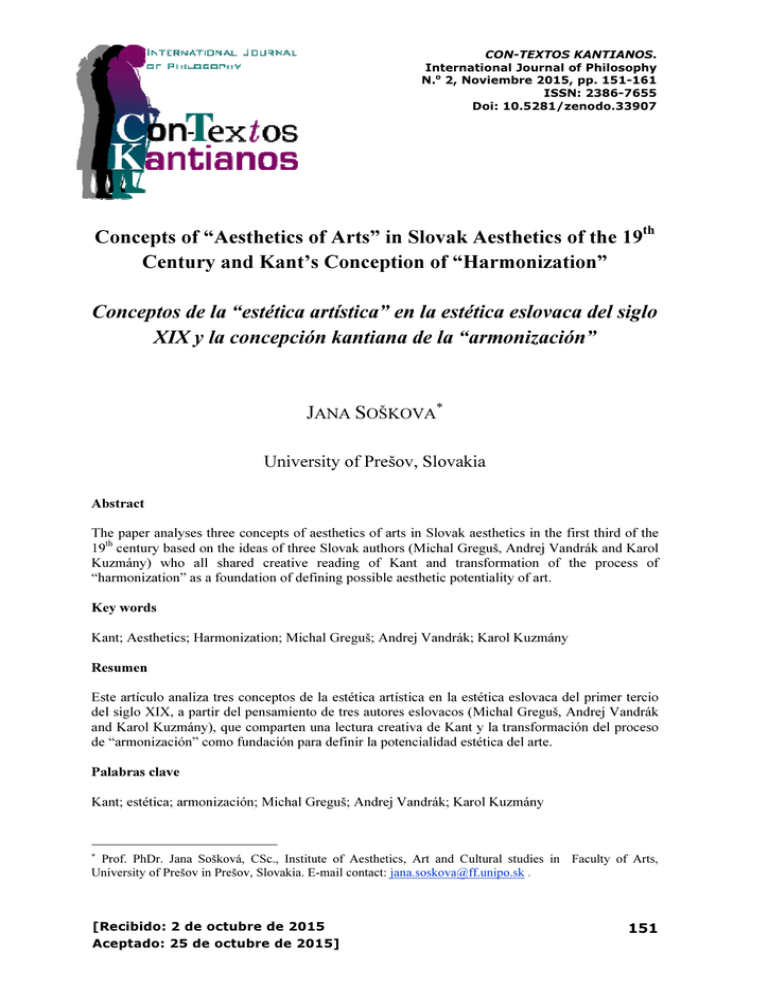
CON-TEXTOS KANTIANOS. International Journal of Philosophy N.o 2, Noviembre 2015, pp. 151-161 ISSN: 2386-7655 Doi: 10.5281/zenodo.33907 Concepts of “Aesthetics of Arts” in Slovak Aesthetics of the 19th Century and Kant’s Conception of “Harmonization” Conceptos de la “estética artística” en la estética eslovaca del siglo XIX y la concepción kantiana de la “armonización” JANA SOŠKOVA∗ University of Prešov, Slovakia Abstract The paper analyses three concepts of aesthetics of arts in Slovak aesthetics in the first third of the 19th century based on the ideas of three Slovak authors (Michal Greguš, Andrej Vandrák and Karol Kuzmány) who all shared creative reading of Kant and transformation of the process of “harmonization” as a foundation of defining possible aesthetic potentiality of art. Key words Kant; Aesthetics; Harmonization; Michal Greguš; Andrej Vandrák; Karol Kuzmány Resumen Este artículo analiza tres conceptos de la estética artística en la estética eslovaca del primer tercio del siglo XIX, a partir del pensamiento de tres autores eslovacos (Michal Greguš, Andrej Vandrák and Karol Kuzmány), que comparten una lectura creativa de Kant y la transformación del proceso de “armonización” como fundación para definir la potencialidad estética del arte. Palabras clave Kant; estética; armonización; Michal Greguš; Andrej Vandrák; Karol Kuzmány Prof. PhDr. Jana Sošková, CSc., Institute of Aesthetics, Art and Cultural studies in Faculty of Arts, University of Prešov in Prešov, Slovakia. E-mail contact: jana.soskova@ff.unipo.sk . ∗ [Recibido: 2 de octubre de 2015 Aceptado: 25 de octubre de 2015] 151 Jana Soškova The tradition of aesthetic thinking in Slovakia has not been long. In theory, it has been developing from about the beginning of the 19th century. Its specific feature is that from its outset it has been linked with the European theoretical thinking and that is has responded to the state of the art in the world as well as in Slovakia. In the first third of the 19th century, three forms of designing the aesthetics accommodated in Prešov, incurred by the different reading of I. Kant and his followers (F. Bouterweck, W. Krug, and F. Fries). They were M. Greguš in his work Compendium Aestheticae1 (1826, the first guide to aesthetics in Slovakia written in Latin) and A. Vandrák in the work Elements of Philosophical Ethics2 (1842) and Karol Kuzmány in his work On Beauty3. Both of them differently perceived the possibilities of aesthetics to give an account on art and perceived differently even the sense of art itself. M. Greguš accepts Kant’s understanding of the aesthetics as “a transcendental science of all a-priori principles of sensuality […] and […] propedeutics of each philosophy”4 as an inter-world between the theoretical and the practical, that is, between knowledge and acting. M. Greguš explains aesthetics as science, whereas, unlike Kant, he 1 Greguš, M. (1793-1838), after studying at the Bratislava Lutheran Lyceum, he completed his university education at the universities of Göttingen and Tübingen. He also visited the famous educational centres in Jena, Halle, Leipzig, Berlin, and Dresden. From the year 1817, he took over the post of Professor at the Prešov Lutheran College after Ž. Carlowszky. He lectured in philosophy, history, mathematics, physics, philosophy of religion, and aesthetics. In the years 1831-32 he was the Director of the Prešov Lutheran College. From 1832 he served on the Lutheran Lyceum in Bratislava, lecturing on philosophy, history, and aesthetics. At the time of his establishment in Bratislava in the same Lyceum, there studied prominent Slovak thinkers such as Ľ. Štúr and J. M. Hurban, who considered him “the most philosophical head among their professors”, praising his philosophical and aesthetic competence, his freedom of thought, and tolerance as a representative of the Hungarian nationality. He wrote in Latin (Logic 1833, Metaphysics 1834, Practical Philosophy 1835) and in Hungarian (Encyclopedia of Philosophy 1835, Philosophy of History 1836). All of his works remained in manuscript. The only released work is the book written in Latin in Prešov, Compendium Aestheticae in the year 1817 and published in the year 1826. (Cf.: Červenka, J.: Prešovské evanjelické kolégium v dejinách filozofie. In: Zborník prác profesorov evanjelického kolegiálneho gymnázia v Prešove. Prešov 1940, pp. 125-126) 2 Vandrák, A. (1807-1884), graduated from the Prešov Lutheran College, continued in Jena and also visited other university centres in Germany. After returning to Prešov, he worked at the Lutheran College and together with Greguš they created a liberal, free-thinking spirit there. After Greguš had left for Bratislava, he assumed his post of Professor, later became the Rector of the College of Prešov, where he remained for the rest of his life despite various other offers. The Hungarian Academy of Sciences appointed him a membercorrespondent for his scientific merit in the year 1847, in the year 1858 he was granted honorary doctorate from the University of Jena, he was honoured for lifetime achievement in the year 1882 by having been awarded the Small Cross of the Order of Francis Joseph I. He published a wide variety of works in the Hungarian language: Enchiridion Antropologiae Psychicae; Philosophiai elemei ethica; Tiszta Logika, Lélektan, Bőlcseleti Jogtan. (Cf.: Kónya, P.: Andrej Vandrák. In: Antológia z diel profesorov prešovského evanjelického kolégia. Eds. R. Dupkala-P. Kónya, pp. 168-169) 3 Kuzmány, K. (1806-1866): On Beauty, 1836: In: Estetika. The Central European Journal of Aesthetics. XLVII (New Series: III), 2010, Issue 2, pp. 226-237; See: Sošková, J.: Karol Kuzmány’s Pilosophy of Art. In: Estetika. The Central European Journal of Aesthetics. XLVII (New Series: III), 2010, Issue 2, pp. 215225) 4 Greguš, M.: Compendium Aestheticae. In: Studia Aesthetica I. Kapitoly k dejinám estetiky na Slovensku. FF PU Prešov 1998, pp.155-157 152 CON-TEXTOS KANTIANOS International Journal of Philosophy N.o 2, Noviembre 2015, pp. 151-161 ISSN: 2386-7655 Doi: 10.5281/zenodo.33907 Concepts of “Aesthetics of Arts” in Slovak Aesthetics perceives aesthetics (Schönheitslehre) not only as a “critique”, but as a systematic knowledge, “which is united by an idea and basic elements.”5 Criticism could not be based on a single source, according to Greguš; therefore it could not be science. In his opinion, what counts in science is systematic knowledge, which is based on a unifying basis. According to Greguš, the unifying idea in aesthetics is the idea of beauty. While Kant prefers aesthetics as Geschmackskritik or Geschmackslehre, Greguš talks about the Schönheitslehre. And since, in accordance with Greguš, we understand philosophy as a science of the basic laws of human spirit, then aesthetics (Schönheitslehre) is part of philosophy or philosophical science. Greguš distinguishes between general aesthetics and special aesthetics. It is that very specification and the naming of special aesthetics that can be regarded as an interesting shift and the contribution of M. Greguš. While the general aesthetics is actually a philosophy of aesthetics (according to Greguš, it talks about what the unifying idea of aesthetics is, it explains the nature of absolute beauty and relative beauty, all of the forms of both of the beauties, the principles of aesthetic perception, assessment, acceptance of both absolute and relative beauty), special aesthetics is in fact the aesthetics of individual types of art. Special aesthetics explains manifestations of aesthetic regularities in specific art genres. In our view, Greguš’ approach is an interesting attempt to investigate the arts from the aesthetic viewpoint. In the second and third parts of his Compendium, Greguš showed under what conditions it is possible to make the aesthetic analysis of individual works of art; he distinguished the aesthetic analysis of art from the history and theory of art and from art criticism. He didn’t perceive aesthetics as “Kritik”, but as “Lehre”, i.e. the doctrine leading to objective knowledge. Such knowledge is also possible in relation to art. In addition to the usual terms of aesthetics (beautiful, ugly, sublime, tragic, comic, aesthetic idea), Greguš also explains the general concept of “aesthetic” which would include all the possible forms of “aesthetic”. Applying the lessons learned from I. Kant, he departs from the assumption that “the aesthetic” is based either on a free play (imagery, imagination, thinking and feeling), or on the feeling of harmonisation, or on the feeling of heading towards infinity and perfection. These three characteristics of the peculiarity of the “aesthetic” are also an explanation of a kind of “involvement” of the aesthetic, which Greguš explains. As it is commonly known, I. Kant explained the characteristics of the “aesthetic” in his Critique of Judgement as a question of “non-involvement of aesthetic judgements”, while Kant explained “non-involvement” as non-involvement in the realistic existence of objects and their practical usefulness, because, according to Kant, what assesses the aesthetic judgement is not an object in itself, but the idea about the object. The idea of the object encourages further imagination, feelings, but is also engages the mind. The ideas and feelings thus released are seen as likeable or unlikeable, not the object itself, whose existence is unimportant in the assessment of its perception. By thinking over Kant’s explanation of the emergence of aesthetic judgements, their nature, validity, and orientation, Greguš named what actually the “aesthetic involvement” is. Briefly and 5 Ibid., p. 158 CON-TEXTOS KANTIANOS International Journal of Philosophy N.o 2, Noviembre 2015, pp. 151-161 ISSN: 2386-7655 Doi: 10.5281/zenodo.33907 153 Jana Soškova simply, aesthetic involvement is an endeavour of man to remain in the aesthetic condition and in the condition of assessing the freed needs, thinking, and feeling. Greguš reasons that such an assessment is also possible in relation to artistic works, because not only nature, but also works of art are capable of releasing ideas and feelings, therefore the way of exerting their effect on man can be aesthetically assessed. According to Greguš, what is specific for the “aesthetic” are three symptoms justified in Kant’s Critique of Judgement: the feeling of harmonisation, the feeling of heading toward the infinity and perfection, and the feeling of free play of fantasy, thinking, and feeling. If we identify three of these symptoms in the perception and evaluation of works of art, then the aesthetic analysis of art becomes possible. In Greguš’ Guide to Aesthetics we find parts which are directly devoted to and named by the term Aesthetics of Art. Greguš differentiates the three aesthetic principles from moral, practical, psychological, art-scholarly and art-critical assessment of the art. Aesthetic exploration of the art should, according to Greguš, explain not only the division of fine arts, clarification of the concept and the essence of art (which, in essence, is made by the history and theory of art and art criticism), but, in particular, to explore, to show, and to explain aesthetic perfection as such. The aesthetics of art, by Greguš, is to explore how we achieve aesthetic perfection in specific kinds of art, how it is possible to achieve aesthetic perfection in the method of artistic creation. In his Special Aesthetics, Greguš defines the aesthetic principles, for which he considers the following: the principle of harmonisation, the principle of idealness and transcendence, and the principle of compliance. In order to clarify how the co-operation of the aesthetic principles, the content, and the artistic expression works, Greguš uses the concept of sign (Zeichen). The principle of compliance and the one of sign are those factors which, according to Greguš, allow one to “aesthetically” explore the art. The explanation of the ideational content of art, its moral implications, or social functions is not principal in it, but how in the particular artistic work (its type and genre) all of these aesthetic principles are carried out. He considers the principle of compliance and the principle of sign the most important. The principle of compliance relates, according to Greguš, to an integral human nature, which, according to him, lies in the basis of the feeling of the beautiful. Greguš says: «The feeling of the beautiful comes from the indivisible human nature, thus it manifests the idea of compliance; it is, however, not less focused on the idea of perfection and is related to the feelings of truth, goodness, and divinity. Therefore, the objects in which we effortlessly find compliance or harmony, and which, as completed, give impetus to the realization of infinity, operate on a spirit in such a way as to lead the state of his nature to the absolute and forward-oriented, thus they invoke a feeling of pleasure» (§11 Compendium Aestheticae).6 The term of compliance is therefore related to the integral human nature, with recognition of harmony in perceived objects, but also to the state of spiritual forces, which is called for 6 Ibid., p. 161 154 CON-TEXTOS KANTIANOS International Journal of Philosophy N.o 2, Noviembre 2015, pp. 151-161 ISSN: 2386-7655 Doi: 10.5281/zenodo.33907 Concepts of “Aesthetics of Arts” in Slovak Aesthetics by the perception of objects. Compliance relates to the ability of the integral human nature to get into a state of “concentration” on knowing perfection, the infinity, forward-looking, into overlapping the borders of man... The principle of compliance, according to Greguš, manifests itself as an aesthetic principle in creating the idea of the beautiful in the consciousness of the perceiving subject. Perception depends on the sensory abilities of man, but Greguš speaks of the outer and the inner senses, by which we perceive beauty, and which have to be in compliance. Therefore, it’s not just about watching, looking at, physical listening to, and the mechanical response to the same in perception. It is not only about the perception of the form by external senses. As one of the few readers, interpreters, and followers of Kant, Greguš does not derive “formalism” from Kant’s aesthetics as the main principle of aesthetics, nor external sensuousness as the main principle of aesthetics. Greguš recognizes the difference between internal and external senses, but also their possible unification. In the external senses, he sees the focus of man on external objects. By perceiving the external senses we recognize the quality of objects. Mental states, released by perception through the external senses, are considered internal senses by Greguš. He also applies this division in relation to the concept of Stoff (substance) and Inhalt, i.e. the content. The concept of form (in the interpretation of Greguš this is the German notion of Gestalt, not Form!) is referred to by Greguš to the mode of perception, i.e. to the manner in which it is perceived as a whole and the unity. He includes the notion of “expression” (Ausdruck) within the outer sense, and he includes the notion of “sign” (Zeichen) within the form of the internal sense. We need to achieve “aesthetic compliance” in perceiving, according to Greguš. In §14 he explains that aesthetic compliance should be distinguished from logical compliance. He understands aesthetic compliance 7 as compliance in diversity, and this is manifested in three components: (a) compliance of the signs of the object, i.e. the harmony of its internal form; (b) compliance of the object with the status of our spirit – its forces are brought into harmonious activity – it is a harmony of the external form, i.e. that of relationship; (c) compliance of ideas and feelings during perception – this belongs in the content (Inhalt) or expression (Ausdruck). It’s actually the unity of expression. Greguš adds one more note on the interpretation, which explains the whole process of the aesthetic operation of the art. He says: because a particular expression (signing) is connected with certain shapes (as signs), experience is necessary, which teaches that mental states are linked to certain statements. Greguš further makes a distinction between absolute aesthetic perfection (the idea of absolute beauty) and the relative aesthetic perfection (relative beauty). The ideals of absolute beauty may not be found, in his opinion, in the nature or in the arts, but only in the mind. In the artist’s mind, these ideals form a kind of a protomodel (Urbild), which the artist then reflects in a specific work of art.8 The art by Greguš embodies the aesthetic principles in different ways and by different means. Greguš reacts, among other things, on § 8 and § 9 of Kant’s Critique of Judgement in which Kant explains how and why the harmonization of the states of mind is possible and 7 8 Ibid., p. 163 Ibid., p. 165 CON-TEXTOS KANTIANOS International Journal of Philosophy N.o 2, Noviembre 2015, pp. 151-161 ISSN: 2386-7655 Doi: 10.5281/zenodo.33907 155 Jana Soškova what its consequences for the feeling of pleasure and aesthetical judgement are. I would claim that Greguš grasped the implications of Kant’s reasoning very well. Going back to Kant’s Critique of Judgement and the abovementioned paragraphs, Kant deals there with the “universability of pleasure” and its subjectivity, and investigates the question whether the feeling of pleasure precedes the judgement of taste or is its consequence. In § 8 he explains that the judgement of taste, by which we describe anything as beautiful, has a claim to the universal validity and without this claim it would fail, nevertheless it is subjective. According to Kant, aesthetic judgements of objects rest upon concepts of the object and the validity of the reference of a representation is connected to the feeling of pleasure and displeasure. Universality of this type of judgement is then not logical, but aesthetic, i.e. it does not involve any objective quality of the judgement, but only one that is subjective – as Kant calls it – universal validity. This validity does not denote the validity of the reference of a representation to the cognitive faculties, but to the feeling of pleasure or displeasure for every subject. Judgements are, according to Kant, subjective, but with the possibility of universal agreement. In the following § 9, Kant more closely specifies what the key to the critique of taste is and emphasises that it is the universal communicability of the state of mind in the given representation, which as the subjective condition of the judgement of taste, must be the basis, with the pleasure in the object as its consequence. Kant emphasises that what is communicated is only the representation that pertains to cognition. This representation brings into a free play the cognitive powers, and hence, the state of the mind in this representation must be one of a feeling of the free play of the cognitive powers, and, it must be universally communicable. This state of mind is not based on cognition, however, it is involved in the free play of imagination and understanding. According to Kant, only this purely subjective (aesthetic) judging of the object, or of the representation through which it is given, is antecedent to the pleasure in it, and is the basis of this pleasure in the harmony of the cognitive faculties. Kant warns that the natural propensity of mankind to “sociability,” which is given empirically or psychologically, is not sufficient for explaining the harmony of the cognitive faculties. How is it then possible that the man is conscious of mutual accord of the powers of cognition in a judgement of taste? In the next part of § 9 Kant points out the more lightened play of both mental powers (imagination and understanding) enlivened by their mutual accord and says that a representation which is singular and independent of comparison with other representations, and, being such, yet accords with the conditions of the universality that is the general concern of understanding, is one that brings the cognitive faculties into that “harmonic accord” which we require for all cognition and which we therefore deem valid for everyone. In this connection Kant uses the terms accord and concord. Greguš’ understanding of Kant was mainly aimed at emphasising harmonization, concord, accord among cognitive faculties, consideration, conditions of universability and subjective judgements of the way of imagination and harmonization of the spirit and mind. It is exactly the realization of harmonization of cognitive powers that liberates the feeling of pleasure and displeasure, followed by the feeling of accord and 156 CON-TEXTOS KANTIANOS International Journal of Philosophy N.o 2, Noviembre 2015, pp. 151-161 ISSN: 2386-7655 Doi: 10.5281/zenodo.33907 Concepts of “Aesthetics of Arts” in Slovak Aesthetics concord between the object being judged and our state of mind. Here is the source of all subjective validity of pleasure which is attributed to the representation of an object which we later call beautiful. What is beautiful is not the object itself, but our representations of the object. That is why Greguš talks about “accord”, “compliance” (of our representation of the object with a universally possible representation of the object), and that is why he talks about “harmonization” of all spiritual powers. A. Vandrák offers another explanation of aesthetics. In his work Elements of Philosophical Ethics (1842) he includes aesthetics in the philosophy of objectives. Vandrák says: «In respect of the objectives lurking in the concept of philosophy, the wise life is the philosophy: with regard to its mission and function, it is a guideline for this wise life; due to the way of its functioning, it is then philosophizing, i.e. rational examination of the being and its final objectives (Analysis); with regard to its results and content, it is by pure reason looked for and set up system of the main truths (principles and ideas), thus the science (Synthesis)».9 Vandrák emphasizes such an understanding of philosophy and the inner classification of its disciplines, which would not be made problematic by the dichotomy between the theoretical and the practical, knowledge and action. The traditional division of philosophy in theoretical and practical (what I. Kant observed as well) is made problematic by the psychological impact (the influence of F. Fries). Vandrák reasons that even the knowing reason is already acting, active; on the other hand, the acting cannot exist without the possibilities of knowledge. 10 Therefore, he divides philosophy in the philosophy of causes and the philosophy of objectives. The philosophy of causes deals with exploring causal connections, and the philosophy of objectives deals with purpose contexts. Beliefs play a role in both of these, values and goals of human life, the objectives (Zwecke) of the world. This knowledge exerts impact on our soul by giving orientation to our daily lives. The philosophy of objectives then, according to Vandrák, brings together theoretical and practical dimensions into a single meaningful whole. The philosophy of science is divided by Vandrák in two sciences: “the science of the actual value and objectives of deeds, the science of life wisdom, under the notion of ethics, a science of morality” and the “science revealing the objectives of life, the sacred origin of beings and their eternal order named dogmatics, aesthetics”. Both ethics and aesthetics are part of the philosophy of objectives, even though they have different subjects, „the truths of the two are united in the belief of man”.11 Vandrák’s structure of ethics also includes aesthetic themes, and his aesthetics contains ethical topics. In the science of morality, there are inherent aspects and knowledge of the science of the beauty, the dogmatics. Within the framework of ethics, special ethics 9 Vandrák, A.: Prvky filozofickej etiky. In: Antológia z diel profesorov Prešovského evanjelického kolégia. I. Filozofia. Eds. R. Dupkala, P. Kónya. Prešov 1999, ISBN 80-85668-89-0, p. 178 10 Ibid., p. 175 11 Ibid., pp. 174-175 CON-TEXTOS KANTIANOS International Journal of Philosophy N.o 2, Noviembre 2015, pp. 151-161 ISSN: 2386-7655 Doi: 10.5281/zenodo.33907 157 Jana Soškova is delimited – the theory of State and law, politics, philosophy of law as the application of the general ethics on the external conditions of life, and doctrine of virtues, focused on the inner virtues of man, i.e. the sentiments, feelings, desires, aspirations, will, and virtues. In the doctrine of virtues, aesthetic themes are also contained. Vandrák says that what is required by wisdom is in part duty or moral, i.e. “it is necessary this way” and partly the unforced spiritual beauty. The aesthetic theme is subordinate to the ethical base, its meaning and results in the consequences. Without aesthetics (spiritual beauty), the science of the dignity and beauty of the soul would not be fulfilled; dogmatics is learning about the value of the real objectives of human life.12 Aesthetics and dogmatics is part of ethics, according to Vandrák. Vandrák did not understand the beauty either sensually or hedonistically. He perceived it as a selfless sentiment creating a humanistic dimension of man. Even his definition of beauty is in a similar vein: “We call beautiful what is pleasing in itself from the very self and for itself.”13 Only selfless beauty, unrelated to selfish individual interests, may be liked. But it rises in the soul of man, is predominantly a mental beauty, which is dependent on the dignity and virtues of the soul. Vandrák wants to reconnect what Kant separated and distinguished (sensuousness, customs, and common sense). Spiritual beauty is characterized by the idea of honour, mental charm, mental health, mental emotion, and obedience to God. All of the above ultimately result in the moral and beautiful life. Intellectual, aesthetic and moral abilities are associated in the soul of man as the basis of moral action. The task of the virtue is, according to Vandrák, “to form life ... in such a way that it be beautiful, i.e. spiritually healthy.”14 It is the selfless and from egoism delivered dimension of the aesthetic (beauty) that can cause that moral duty will not become a command by compulsion (which I. Kant favoured), but from the free inner willpower. According to him, the aesthetic fundamentals also embrace such moral values as love, friendship, “dignity of the human being, that is, his true honour”. It is right here where, according to Vandrák, not only the duty has to function (compulsion), but “the virtue of the intellectual beauty, the nature of the personality.”15 Vandrák follows and quotes Fries’ work Wissen, Glaube und Ahndung16 (Jena 1805), in which Fries explains that he wants to link being and thinking, that does not want to depart solely from one or the other, because being has the superiority, and anything thought is already being. Fries’ Wissen (knowledge) applies to matter, spirit, and belief (Glauben) that relates to the purpose, eternal good, intelligible world, eternity, human sojourn (Dasein) and freedom of will. By clarifying the concept of retribution (Ahndung) relating to the secrets of the teleology of nature and the possibility of its assessment under the laws of beauty and sublime, Fries offered to Vandrák the opportunity to overcome Kant’s understanding of the aesthetic world as the possible, the probable, and anchor it in 12 Ibid., p. 176 Ibid., p. 179 14 Ibid. 15 Ibid., p. 183 16 Fries, J. F.: Wissen, Glaube und Ahndung. Jena 1805. 13 158 CON-TEXTOS KANTIANOS International Journal of Philosophy N.o 2, Noviembre 2015, pp. 151-161 ISSN: 2386-7655 Doi: 10.5281/zenodo.33907 Concepts of “Aesthetics of Arts” in Slovak Aesthetics piety (Andacht), which through subsequent enthusiasm allows one to imagine the secret of being as the path to divinity. Aesthetics becomes part of ethics as the philosophy of objectives. What is then at stake in the aesthetics is not merely simple assessment, sensuousness, but for the mental beauty as a virtue it’s an overlap of the terrestrial to the extraterrestrial. Neither aesthetics nor art as creation that embodies the creative power of the spirit have any purpose in themselves, it is rather in practical humanity. Different readings of Kant’s critique by Greguš are also apparent in relation to the understanding of aesthetics and the meaning of art. Greguš tends more to the understanding of aesthetics as a descriptive science, which arrives at the knowledge of what is going on in the aesthetic assessment with the subject of assessment, and what the object of assessment is, i.e. art and the relaxed state of feeling and thinking of the person appreciating the art. Greguš names the object of aesthetics and the way this should be done. I have already pointed out that his contribution is conceptualizing the “aesthetics of art”. According to Greguš, the sense of art lies in the fact that it creates images, artworks, in which Stoff, Inhalt, Gestalt, and Ausdruck are manifested. On the basis of the above, the “aesthetic compliance of the object and the state of the spirit” manifests itself. Works of art are signs and notices of these aesthetic compliances. Therein lies the ethos of art by Greguš. Vandrák subsumes aesthetics under ethics and his exploration of art leads toward the definition of the purposes of art – it is a mental beauty as the quality of goodness and piety, it is a cultivating and moral consequence of the works of art, it is attaining the eternal through the final.17 Vandrák pushes the understanding of the aesthetics (and of the art) towards pragmatic outlet of the moral-religious-aesthetic disposition of man, which is reflected both in assessment and in making of art. The meaning of art is identifiable through pragmatic and practical goals which the art has to perform.18 In Slovak Kantian tradition, K. Kuzmány 19 continues in Fries’ and Fichte’s modification of Kant’s explanation of harmonization and its influence on a perception of art and a beingness of art.20 He differs from Kant in his attempt to achieve a synthesis of cognition, aesthetic judgement, and moral action in the form of the unification of thinking, feeling and the will, and also a great acceptance of mystically conceived final sense of art. Art and beauty are, for him, the knowledge, moral action and judgement. In Kuzmány’s conception, the unity of all faculties of man (feeling, thinking and will) does not have such a radically mystical outcome as the one we find in Fries.21 Kuzmány is inspired by Fries in 17 Although both of these works were written in Prešov, their impact soared across Slovakia, since M. Greguš was a lecturer in aesthetics from 1832 until the end of his life and A. Vandrák’s disciple’s works, although having stayed in Prešov, were mainly known in the Lutheran milieu at colleges all over Slovakia, more precisely, the former “Upper Hungary”. 18 In addition to the aesthetics following the line of I. Kant, the aesthetic thought in that time in Slovakia developed in the line of Hegel’s and Schelling’s ideas. Particularly attractive is Hegel’s idea of the art, whose purpose is to elucidate sensually the idea of beauty, identical with the idea of goodness and truth, as well by Hegel defined limits of art. 19 Kuzmány, K.: On Beauty. In: Estetika. The Central European Journal of Aesthetics. 47 (2010), Issue 2. 20 Sošková, J.: Karol Kuzmány’s Philosophy of Art. In: Estetika. The Central European Journal of Aesthetics. 47 (2010), Issue 2. 21 Jacob Friedrich Fries: Wissen, Glaube und Ahndung. Jena: Gopferdt, 1805. Also in idem: Sämtliche Schriften, vol. 3; pp. 413-755 (Aalen: Scientia, 1968) CON-TEXTOS KANTIANOS International Journal of Philosophy N.o 2, Noviembre 2015, pp. 151-161 ISSN: 2386-7655 Doi: 10.5281/zenodo.33907 159 Jana Soškova that he considers feeling to be a cognitive faculty. But whereas Fries considers feeling to be the equal of intuitive awareness, Kuzmány sees it as something distinct and puts it into a hierarchy. There is, according to Kuzmány, only one essence, but it exists in three forms, as truth, beauty, and moral good. It is known, felt, desired, and ultimately intuited by the mind and internally observed as “stripped bare”, that is, beyond time and space. The connection between truth, beauty, and moral good is, according to Kuzmány, in the one essence, in the indivisibility of the human spirit, in three forms of idea, which is created by the unmediated consciousness of man’s mind and intuitive awareness. Kuzmány points out that: a) science investigates, and makes known the truthfulness of truth, beauty, and moral good; b) art represents, and makes one feel the beauty of truth and moral good; c) religion leads to consciousness of the moral good, truth, and beauty. Kuzmány’s feeling by the mind is an intuitive awareness, which, in seeing beauty, surmounts the limits of reason, and, in the form beauty, sees essence revealed, not veiled by time and space. Feeling by the mind is not a sensory phenomenon; it is the world of beauty rooted in art, which provides the first possibility of seeing the essence of the object in front of it. The second act of the workings of the spirit is observing that the aesthetic world is present, that we “catch ourselves” seeing the essence of the object by means of beauty, that is, we have an intuitive awareness. Only in that culmination, that is, by means of sublime, which is fully dependent on stripping away time and space, which veiled the essence of the object, we do have “naked” essence, that is, revealed, unveiled essence before our minds. We cannot understand this essence by reason, but we can feel it with our minds in intuitive awareness. This essence – felt by the mind in intuitive awareness – cannot even be explained by reason, nor can it be ascribed meaning that has been justified by reason. Kuzmány’s philosophical and aesthetic position is consistently projected into his conception of art. This conception often makes his conception of aesthetics more precise and more comprehensible. According to him, “the aim of all arts is the creation and representation of the beautiful, or creation and representation of certain objects in a way that makes it possible to feel their essence, that is to say, that which is a value in and of itself and is the supreme aim of all endeavours of the soul.” 22 Art is therefore not an imitation; it is creating and presenting something beautiful so that by means of beautiful it is possible to feel, and then have an intuitive awareness of essence itself, that is, the truth and the value of the object created and presented by the artist. In this way the aesthetic, the artistic, and, ultimately, also the philosophical come into harmony in Kuzmány’s conception. With art we create the Being itself, we reveal its truth by means of the beautiful, and by its increase into a form of the sublime we cross the boundary of our own subjective existence.23 22 23 Kuzmány, K.: On Beauty, p. 230 Ibid., p. 232 160 CON-TEXTOS KANTIANOS International Journal of Philosophy N.o 2, Noviembre 2015, pp. 151-161 ISSN: 2386-7655 Doi: 10.5281/zenodo.33907 Concepts of “Aesthetics of Arts” in Slovak Aesthetics Bibliography Fries, Jakob Friedrich (1805), Wissen, Glaube und Ahndung. In Sämtliche Schriften, Vol. 3, pp. 413-755. Aalen: Scientia Verlag 1968. Greguš, Michal (1998), Compendium Aestheticae. In: Studia Aesthetica I. Kapitoly k dejinám estetiky na Slovensku. FF PU Prešov, pp. 155-157. Kant, Immanuel (1975), Kritika soudnosti (Critique of the Power of Judgement). Praha. Kuzmány, Karol (2010), On Beauty. In: Estetika. The Central European Journal of Aesthetics XLVII (New Series III). 2010, Issue 2, pp. 226-237. Sošková, Jana (2001), Od teoretickej ku aplikovanej estetike. Problémy filozofie dejín estetiky na Slovensku. Prešov 2001. ___________ (2010), Karol Kuzmány’s Philosophy of Art. In: Estetika The Central European Journal of Aesthetics XLVII (New Series III). 2010, Issue 2, pp. 215-225. Vandrák, Andrej (1999), Prvky filozofickej etiky. In R. Dupkala – P. Kónya (eds). Antológia z diel profesorov prešovského evanjelického kolégia. I. Filozofia. Prešov. CON-TEXTOS KANTIANOS International Journal of Philosophy N.o 2, Noviembre 2015, pp. 151-161 ISSN: 2386-7655 Doi: 10.5281/zenodo.33907 161
